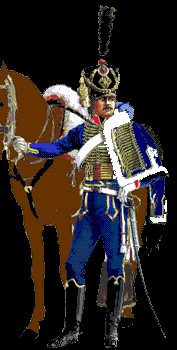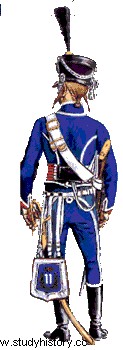Created by decree of the Convention on July 28, 1793, the eleventh regiment of hussars will take part in the Vendée war, then it campaigns on the Rhine in 93. It will then be on the Bidassoa in 1794, in Germany in 1796 and 1797, in Italy in 1799 and 1800.
-

- 11th Hussar
-

- 11th Hussar
With the reorganization of year XII, the regiment becomes 29th dragoons and it will be necessary to wait until 1810 to see reappearing the eleventh hussars reformed with the regiment of Dutch hussars. For these Dutchmen, veterans of the great army, this will be the sine reward of their valour.
These men have indeed distinguished themselves during many campaigns that we will recall. Gathered in Holland in 1797, they will be engaged against the English in 1799, then in Germany under the orders of Augereau in 1800 and 1801.
In 1805, they were assigned to the second corps of the Grand Army commanded by Marshal Marmont. With the 6th hussars and the 8th chasseurs, they form the Lacoste division. They will participate in the whole campaign, will distinguish themselves at Altmark, but they will not be engaged directly in Austerlitz.
In 1806 and 1807, they will serve in the 8th corps of Marshal Mortier and fight the Swedes of Baron d'Essen in particular in front of Colberg. In 1809, while Napoleon was engaged against Austria, Prussia was agitated and in young Westphalia troubles broke out, armed bands began an uprising. The Prussian major Schill will constitute the most formidable of these bands. Among the troops that General Gratien will lead in pursuit of the major are Dutch hussars. On May 25, Schill arrives in front of Stralsund and liberates the city of which he immediately organizes the defenses. It was on May 31 that General Gratien launched an assault on the Dutch and, during furious fighting, a Dutch hussar shot down the Prussian major with a saber. The death of the famous gang leader decides the victory. The revolt is put down. While these battles are taking place in northern Germany, four squadrons of Dutch hussars have been directed to Spain.
SPAIN...
On October 25, 1808, the Dutch squadrons entered Spain. They were immediately directed towards the fourth corps commanded by Marshal Lefevre and on October 31 the hussars took part in the offensive launched by the Marshal against Blake's troops.
It is the victory of Durango, but this victory is incomplete, the attack will be considered premature because it allowed the troops of La Romana to escape a total encirclement.
The hussars will then be engaged in multiple operations, particularly in the Toro sector where Lieutenant Colonel Van Housse will be seriously injured.
The Spanish armies threaten the troops of King Joseph, but the French will take the offensive.
While Victor is marching against Cuesta's army, which he is going to defeat in Medelin on March 28, the fourth corps under the command of Sebastiani is going to fight Cartoajal's army.
Sébastiani leads his three divisions (Sébastiani, Leval and Valence), and General Milhaud's dragoon division (5th, 12th, 16th, 20th and 21st dragoon regiments). The Dutch hussars march with this corps. On February 11, the Duke of Albuquerque who tries to block the passage is pushed back. On the 26th, Sébastiani's vanguard was stopped in front of the Guadiana, the bridge of which remained intact. the cavalry. The Dutch were particularly distinguished, Colonel Van Roesk Van Alkemade, wounded in this fight, was saved by the trumpet major of the regiment named Himmerman. Brought back to Valdepenas, the hussars will be engaged in many limited operations, but the Spanish armies are reforming and with the support of the Portuguese and the English of Sir Arthur Wellesley they will resume the offensive.
On July 27, it is the battle of Talavera, they will participate brilliantly in the fight against Venegas and, on August 1, Sebastiani wins the great victory of Almonacid, destroying the small army of the Spanish general. Sir Wellesley, who had become Lord Wellington, was appointed generalissimo but remained on the defensive, the junta which still wanted to attack launched a new army forward with a new general:Areizaga. This new army will also be defeated at Ocana on November 19. This will be the last fight of the Dutch hussars in Spain. We find them in Madrid with the 26th chasseurs at the beginning of 1810. A squadron will be assigned to the first hussars, the others will join the depot of Bois-le-Duc to form the eleventh hussars in accordance with the decree of August 18, 1810.
THE ELEVENTH HUSSARS 1810-1814
Organized in Arras by its colonel, Gérard de Collaert, the regiment will be paid in January 1812 into the corps of Marshal Ney which will become in April the third corps of the grand army. The hussars form with the 6th light horse the gth light brigade (General Mouriez). The Württemberg hunters (n° 4) walk with them. The third corps also includes the 14th light brigade of General de Beurman assisted by General de Bruning. This brigade includes the 4th and 28th hunters and the Württemberg hunters nOs 1 and 2. The regiment crosses the Niemen on June 24, 1812. Murat will take command of the vanguard, the eleventh hussars participates in this discovery in front of the Russians who refuse the fight.
On August 13, they are in Chalovo and Khornino covering the left wing.
August 14, the first serious fight in front of Krasnoi, there is the reinforced Nemjerowski division, a 10-piece battery is covered by Charkov dragoons. Marshal Ney himself will lead the attack, but the Russian resistance will be stubborn and their retreat will take place in relative order. The hussars have charged and pursued the enemy.
The regiment will be in Smolensk on August 17 covering the left towards Katan. In the progression towards Moscow, the regiment is always in the vanguard, then it is the battle of Moskowa and in the charges of this terrible day, General Mouriez is seriously wounded. The eleventh hussars will charge again to clear the road, General de Beurman has taken the head of the brigade which finally finds the 3rd corps in Moscow. The regiment has only 140 cavalry left.
During the retreat, the reduced regiment will participate in the epic of the rearguard. Against the cold, against the enemy, fighting around Marshal Ney, they were to write one of the most beautiful pages in the history of military courage.
After Malojaroslawetz, Mojaisk, Viasma, Krasnoï, cutting an impossible path through the midst of the Russians, Ney and his men were able to cross the Beresina and finally recross the Niemen. The regiment has only 79 men left, 160 men were evacuated during the campaign, all the others remained "over there".
1813... Colonel de Collaert has been retired in Moscow, the new colonel in Arras is Baron Liégeard. Captain Pependrecht can, in 1813, lead a valid squadron which is assigned to Sebastiani's 2nd cavalry corps. They are part of the small Exelmans division (750 cavalry) chasseurs n° 4, 7, 20, 23 and 24 with the eleventh hussars. Engaged victoriously at Sprottau on May 26, they will suffer at Katzbach, then charge at Leipzig on October 16, then on the 18th. They charge again at Hanau, covering themselves with glory for the last time, since the regiment will be dissolved at the beginning of 1814 and will not be reformed until 1873.
